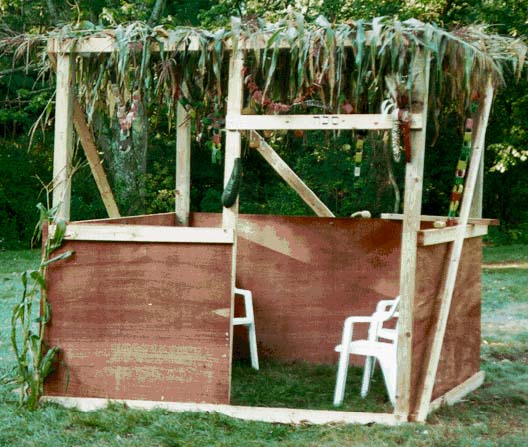“Nothing in biology makes sense except in the light of evolution.”
– theistic evolutionist Theodosius Dobzhansky
 A corollary might be, “Nothing in religion makes sense except in the light of history!” Religions evolve and develop over time, just like organisms. For instance, take the ‘four species’ of Sukkot: palm (lulav), citron (etrog), myrtle (hadas), and willow (arava). The Bible speaks of “taking” these species before building a Sukkah/hut, but does not explain what to do with them:
A corollary might be, “Nothing in religion makes sense except in the light of history!” Religions evolve and develop over time, just like organisms. For instance, take the ‘four species’ of Sukkot: palm (lulav), citron (etrog), myrtle (hadas), and willow (arava). The Bible speaks of “taking” these species before building a Sukkah/hut, but does not explain what to do with them:
| מ וּלְקַחְתֶּם לָכֶם בַּיּוֹם הָרִאשׁוֹן, פְּרִי עֵץ הָדָר כַּפֹּת תְּמָרִים, וַעֲנַף עֵץ-עָבֹת, וְעַרְבֵי-נָחַל; וּשְׂמַחְתֶּם, לִפְנֵי יְהוָה אֱלֹהֵיכֶם--שִׁבְעַת יָמִים. | 40 And ye shall take you on the first day the fruit of goodly trees, branches of palm-trees, and boughs of thick trees, and willows of the brook, and ye shall rejoice before the LORD your God seven days. |
| מא וְחַגֹּתֶם אֹתוֹ חַג לַיהוָה, שִׁבְעַת יָמִים בַּשָּׁנָה: חֻקַּת עוֹלָם לְדֹרֹתֵיכֶם, בַּחֹדֶשׁ הַשְּׁבִיעִי תָּחֹגּוּ אֹתוֹ. | 41 And ye shall keep it a feast unto the LORD seven days in the year; it is a statute for ever in your generations; ye shall keep it in the seventh month. |
| מב בַּסֻּכֹּת תֵּשְׁבוּ, שִׁבְעַת יָמִים; כָּל-הָאֶזְרָח, בְּיִשְׂרָאֵל, יֵשְׁבוּ, בַּסֻּכֹּת. | 42 Ye shall dwell in booths seven days; all that are home-born in Israel shall dwell in booths; |
| מג לְמַעַן, יֵדְעוּ דֹרֹתֵיכֶם, כִּי בַסֻּכּוֹת הוֹשַׁבְתִּי אֶת-בְּנֵי יִשְׂרָאֵל, בְּהוֹצִיאִי אוֹתָם מֵאֶרֶץ מִצְרָיִם: אֲנִי, יְהוָה אֱלֹהֵיכֶם. | 43 that your generations may know that I made the children of Israel to dwell in booths, when I brought them out of the land of Egypt: I am the LORD your God. |
What does it mean to “take” the species? It's unclear. Luckily, they are mentioned again in the days of Ezra (Neh. Ch. 8):
| יד וַיִּמְצְאוּ, כָּתוּב בַּתּוֹרָה: אֲשֶׁר צִוָּה יְהוָה בְּיַד-מֹשֶׁה, אֲשֶׁר יֵשְׁבוּ בְנֵי-יִשְׂרָאֵל בַּסֻּכּוֹת בֶּחָג בַּחֹדֶשׁ הַשְּׁבִיעִי. | 14 And they found written in the Law, how that the LORD had commanded by Moses, that the children of Israel should dwell in booths in the feast of the seventh month; |
| טו וַאֲשֶׁר יַשְׁמִיעוּ, וְיַעֲבִירוּ קוֹל בְּכָל-עָרֵיהֶם וּבִירוּשָׁלִַם לֵאמֹר--צְאוּ הָהָר וְהָבִיאוּ עֲלֵי-זַיִת וַעֲלֵי-עֵץ שֶׁמֶן, וַעֲלֵי הֲדַס וַעֲלֵי תְמָרִים וַעֲלֵי עֵץ עָבֹת: לַעֲשֹׂת סֻכֹּת, כַּכָּתוּב. {פ} | 15 and that they should publish and proclaim in all their cities, and in Jerusalem, saying: 'Go forth unto the mount, and fetch olive branches, and branches of wild olive, and myrtle branches, and palm branches, and branches of thick trees, to make booths, as it is written.' |
| טז וַיֵּצְאוּ הָעָם, וַיָּבִיאוּ, וַיַּעֲשׂוּ לָהֶם סֻכּוֹת אִישׁ עַל-גַּגּוֹ וּבְחַצְרֹתֵיהֶם, וּבְחַצְרוֹת בֵּית הָאֱלֹהִים--וּבִרְחוֹב שַׁעַר הַמַּיִם, וּבִרְחוֹב שַׁעַר אֶפְרָיִם. | 16 So the people went forth, and brought them, and made themselves booths, every one upon the roof of his house, and in their courts, and in the courts of the house of God, and in the broad place of the water gate, and in the broad place of the gate of Ephraim. |
| יז וַיַּעֲשׂוּ כָל-הַקָּהָל הַשָּׁבִים מִן-הַשְּׁבִי סֻכּוֹת, וַיֵּשְׁבוּ בַסֻּכּוֹת--כִּי לֹא-עָשׂוּ מִימֵי יֵשׁוּעַ בִּן-נוּן כֵּן בְּנֵי יִשְׂרָאֵל, עַד הַיּוֹם הַהוּא; וַתְּהִי שִׂמְחָה, גְּדוֹלָה מְאֹד. | 17 And all the congregation of them that were come back out of the captivity made booths, and dwelt in the booths; for since the days of Joshua the son of Nun unto that day had not the children of Israel done so. And there was very great gladness. |
Note that by this time (~450 BCE) the exiled Israelites had forgotten what was written in the Bible or how to keep Sukkot. They appear to have interpreted the Bible’s command to “take” the four species as
“take them… and use them to build a Sukkah!”
To this day, all Jews build their Sukkah using plant materials.
However, the tradition of the “four species” has evolved again since then. By the Rabbinic era, a different interpretation had taken root:
“take them… and bundle them!”
It’s not clear how this tradition of bundling and shaking the four species during prayers arose, but it seems to have happened during the second Temple period (500 BCE-70CE; see Mishna Sukkah 3:8). Perhaps when the Israelites rediscovered Sukkot (in Ezra's day), they were not sure whether the Bible meant “take them… and use them to  build a Sukkah!” or “take them… and bundle them!” Karaite Jews today follow the first interpretation (mentioned in Nehemiah), while Rabbanites follow the second (mentioned in the Mishna).
build a Sukkah!” or “take them… and bundle them!” Karaite Jews today follow the first interpretation (mentioned in Nehemiah), while Rabbanites follow the second (mentioned in the Mishna).
Some people may not like tracing the history of religious traditions, but for me it’s the only way to understand and appreciate them! I’m a scientist, and religions are like living organisms - they can only be understood in the context of their evolutionary history.
 A corollary might be, “Nothing in religion makes sense except in the light of history!” Religions evolve and develop over time, just like organisms.
A corollary might be, “Nothing in religion makes sense except in the light of history!” Religions evolve and develop over time, just like organisms. build a Sukkah!” or “take them… and bundle them!” Karaite Jews today follow the first interpretation (mentioned in Nehemiah), while Rabbanites follow the second (mentioned in the Mishna).
build a Sukkah!” or “take them… and bundle them!” Karaite Jews today follow the first interpretation (mentioned in Nehemiah), while Rabbanites follow the second (mentioned in the Mishna).



6 comments:
I actually heard a shiur on this exact topic yesterday. Very funny title, btw!
@YZF,
I actually heard a shiur on this exact topic yesterday.
Nu, what did they say?
Very funny title, btw!
I try, I try.
It is funny that you mention this because I am reading texts and traditionsby lawrence H. Schiffman and he talks about this exact incident. He says this is an interpretation of the passage in lev. 23.40-42. I don't know if they were correct or not, but remember, the people who were with Ezra were supposedly on 47,000 and they were a small monority of the full Jewish nation. Also, they were supposedly the least learned of the Jews in Babylon. But it is very interesting. However, I don;t know if I would say the Pharisees changed the tradition, maybe they just got their tradition from bavel, which would be the more authentic tradition, since Ezra only brought back so few and supposedly the least learned.
Thx E-man, I will have to check out Schiffman's book, I have heard of him before. Of course with traditions it's quite difficult to figure out what actually happened - just like in biological evolution! Textsources are like fossils, you need to dig more of them up to get a complete picture.
Hi. I hope I get an answer from someone since this post is from 2009.
Do you know you are mentioned in Wikipedia as a reference? lol
Thinking about the four "species" I found something they have in common beside the obvious practical use for building the Sukkah.
Seems that these plants and fruit was used in ancient times for medicinal uses. Maybe this fact had something to do with the time of the year in which you should go to the mountain a gather it in your house. The winter is common, go get some natural "aspirin". Being healthy definitively is connected to being happy as the Torah commands.
However while reading the Hebrew test in the Torah (23 ויּקרא)
מ וּלְקַחְתֶּם לָכֶם בַּיּוֹם הָרִאשׁוֹן, פְּרִי עֵץ הָדָר כַּפֹּת תְּמָרִים, וַעֲנַף עֵץ-עָבֹת, וְעַרְבֵי-נָחַל; וּשְׂמַחְתֶּם, לִפְנֵי יְהוָה אֱלֹהֵיכֶם--שִׁבְעַת יָמִים
Is this suggesting that these are psychedelic? However, I did not find information suggesting that these plants posses psychedelic effects.
All of this is just out of my mind not base on tradition. Just a curiosity.
But what if these plants actually refer to a psychedelic and we just do not know any more to which plants they refer? What is not Ezra neither the Mishna are even close to the mystery of these items?
And, if I learned one think about Jewish "tradition" is that many time these "Jewish" tradition are actually tradition of other civilisation and cultures. I guess some inside into the Babylonian, Greeks and Roman culture can bring some light into these items.
Each of the four species receives its water supply from a different water source: rain, flowing rivers, aquifers, and human irrigation. All are dependent on God. The ancients knew that from their agricultural lives and the bundling/ shaking in different directions symbolized it. The sukkah reflected a national and agricultural perspective, plus an issue of mobility, fragility, and more. The Samaritans hung their four species in the sukkah, but did not build with them.
Post a Comment